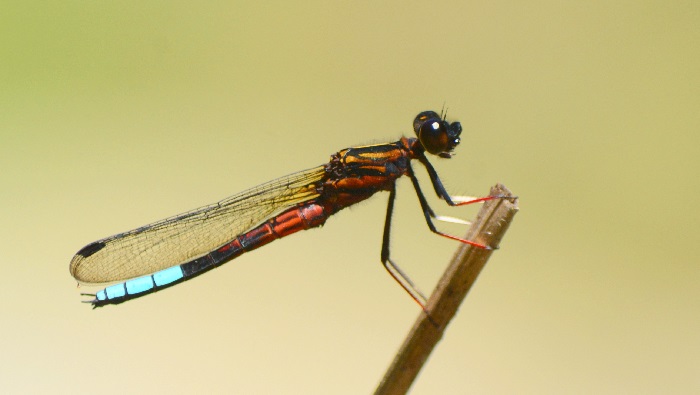Cover photo by Bertie Brink.
Find the Boulder Jewel in the FBIS database (Freshwater Biodiversity Information System) here.
Family Chlorocyphidae
Identification

Moordkuil River, Western Cape
Photo by Ryan Tippett
Small size
Length up to 34mm; Wingspan attains 54mm.
Adult males are distinctive, easily recognised, and unlike any other South African species. The bright red and black colouration is diagnostic. Only the upper parts of the last four abdominal segments are vivid blue. Females are drab beige-brown with darker brown and black markings.
Females and immature males are very similar to those of the Dancing Jewel Platycypha caligata. They are best identified by their association with the males.

Kogelberg Nature Reserve, Western Cape
Photo by Corrie Du Toit
Click here for more details on identification.
Habitat

Photo by Sharon Stanton
The Boulder Jewel frequents swift, rocky streams and rivers in both open and wooded habitats. It is most common in fynbos and grassland in cooler, mid-altitude areas. Often found alongside the more common Dancing Jewel (Platycypha caligata), but the Boulder Jewel generally prefers more open habitats. The Boulder Jewel is the only Platycypha species in the Western Cape.
The Boulder Jewel is found up to 500m above sea level in the Western Cape but occurs up to 1500m above sea level in the Eastern Cape, KwaZulu-Natal, and Mpumalanga.

Photo by Ryan Tippett
Behaviour
Territorial males perch low down, close to the water. Boulder Jewels sit predominantly on rocks but will also rest on overhanging or emergent twigs, reeds and grass. The females are usually found alongside the males. Boulder Jewels are perch hunters, taking short, low flights across the water. Platycypha fitzsimonsi males are well noted for having an eye-catching courtship display. The male hovers in front of a perched female. His legs hang down vertically as he twists or waves them, alternately flashing red and white.
Active from October to May (See Phenology below).

Tradouws Pass, Western Cape
Photo by Ryan Tippett
Status and Conservation
The Boulder Jewel is fairly common but localised and is listed as Least Concern on the IUCN Red List of Threatened Species. It is moderately sensitive to habitat change as it does occur on rivers with some alien plant growth. However, the Boulder Jewel is intolerant of polluted or turbid, dirty water.

Moordkuil River, Western Cape
Photo by Ryan Tippett
Distribution
The Boulder Jewel is endemic to South Africa. Its range follows the escarpment, from the Cedarberg in the Western Cape up to Mpumalanga.
Below is a map showing the distribution of records for Boulder Jewel in the OdonataMAP database as at February 2020.

Below is a map showing the distribution of records for Boulder Jewel in the OdonataMAP database as at December 2024.

The next map below is an imputed map, produced by an interpolation algorithm, which attempts to generate a full distribution map from the partial information in the map above. This map will be improved by the submission of records to the OdonataMAP section of the Virtual Museum.


Ultimately, we will produce a series of maps for all the odonata species in the region. The current algorithm is a new algorithm. The objective is mainly to produce “smoothed” maps that could go into a field guide for odonata. This basic version of the algorithm (as mapped above) does not make use of “explanatory variables” (e.g. altitude, terrain roughness, presence of freshwater — we will be producing maps that take these variables into account soon). Currently, it only makes use of the OdonataMAP records for the species being mapped, as well as all the other records of all other species.
The basic maps are “optimistic” and will generally show ranges to be larger than what they probably are. These maps use the data in the OdonataMAP section of the Virtual Museum, and also the database assembled by the previous JRS funded project, which was led by Professor Michael Samways and Dr KD Dijkstra


Further Resources
The use of photographs by Bertie Brink, Corrie du Toit, and Sharon Stanton is acknowledged.
Boulder Jewel Platycypha fitzsimonsi (Pinhey, 1950)
Other common names: Fitzsimon’s Jewel (Alt. English); Klipjuweeltjie (Afrikaans).
Recommended citation format: Loftie-Eaton M; Navarro R; Tippett RM; Underhill L. 2025. Boulder Jewel Platycypha fitzsimonsi. Biodiversity and Development Institute. Available online at https://thebdi.org/2020/03/02/boulder-jewel-platycypha-fitzsimonsi/
References: Tarboton, M; Tarboton, W. (2019). A Guide to the Dragonflies & Damselflies of South Africa. Struik Nature.
Samways, MJ. (2008). Dragonflies and Damselflies of South Africa. Pensoft
Samways, MJ. (2016). Manual of Freshwater Assessment for South Africa: Dragonfly Biotic Index. Suricata 2. South African National Biodiversity Institute, Pretoria


Good work!
Can the average altitude for all records (in this specific instance) be calculated and communicated, please.